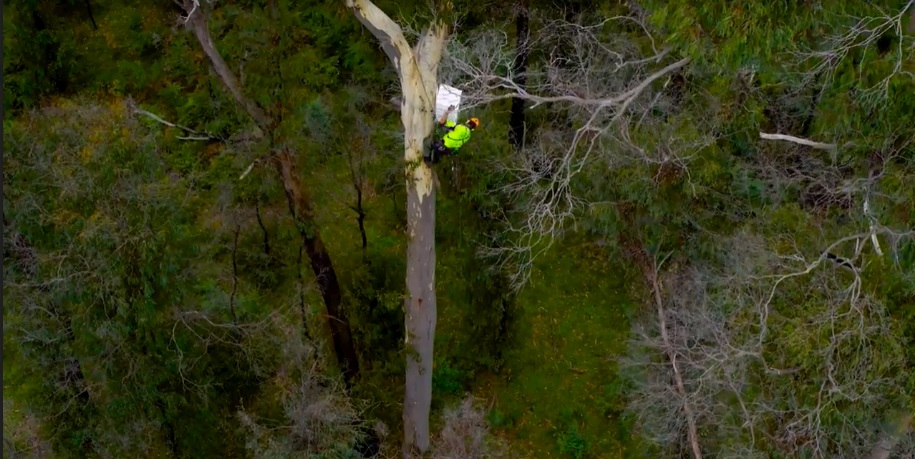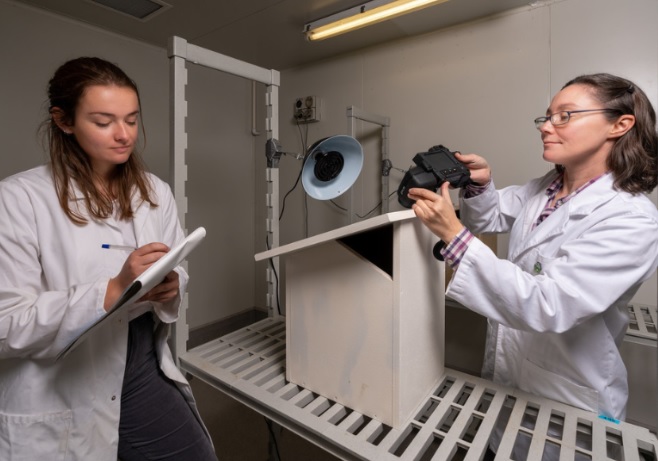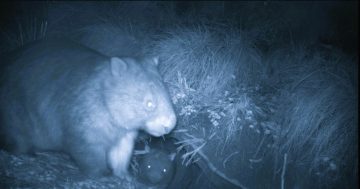
In a massive undertaking 15 kg nest boxes were placed up to 30 m above ground in Tallaganda National Park in a bid to help save the Greater Glider population. Photo: Australian National University.
The humble wildlife nest box has been given a hi-tech overhaul to help recover greater glider populations across the nation, with a forest southeast of Canberra now home to these shelters.
One hundred and twenty elaborate nest boxes, nicknamed “Goldilocks” boxes, have been mounted in fire-affected forests in Tallaganda National Park and state forest in NSW with a further 120 near Bendoc in East Gippsland, Victoria.
The hope is that they will provide ideal conditions for the nocturnal marsupial, known as the “flying koala” or “clumsy possum”, whose population has declined by 80 per cent in the past 20 years due to land clearing, forest destruction, bushfires and climate change.
Close to a third of greater glider habitat burned in the 2019/20 bushfires, raising concerns that the species – already under extinction pressure – faced an even more significant shortage of the tree hollows crucial to their survival.
Tree hollows used by greater gliders can take more than 100 years to form.
Traditional model nest boxes provide an alternative shelter to natural hollows but are constructed with thin walls, so they lack thermal protection and can become far hotter than a tree hollow, exposing greater gliders to extreme temperatures.
Heat-stressed greater gliders eat less and, with naturally low-fat stores, can perish after a few days of not feeding.
But thanks to a partnership between the Australian National University (ANU), World Wildlife Fund (WWF) and Greening Australia a project channelling scientific knowledge of modern building standards using insulation, air gaps and heat-reflective, fire-resistant, non-toxic coatings has created a safer nest box.

Australian National University’s Isabella Howard and Dr Kara Youngentob tested the nest boxes in ANU laboratories before deployment. Photo: Australian National University.
After tweaks and rigorous laboratory testing, specialist teams were deployed to manoeuvre the 15 kg nest boxes into place up to 30 m above ground, the high canopy preferred by the greater gliders.
The areas with nest boxes will be monitored and compared to control sites (with no nest boxes) by Australian National University PhD student Jenna Ridley to test if providing a readymade home can increase greater glider numbers.
ANU research fellow Dr Kara Youngentob said producing and installing the high quality nest boxes was costly.
“So this project is very important because it will help us understand if expensive interventions like nest boxes are the best use of funding in our urgent mission to halt the decline of greater gliders,” she said.
Heat chamber tests showed that fully insulated nest boxes exhibited less temperature variability, remained cooler and importantly never reached the above 40°C heat extremes of less-insulated nest boxes.
Fully insulated nest boxes also maintained heat longer than any other nest box type in a cold room.
WWF Australia threatened species and climate adaptation ecologist Dr Kita Ashman admits to affectionately calling this design the “Goldilocks” box.
“We hope it will keep greater gliders not too hot and not too cold and will help to increase the species’ resilience in a changing climate,” she explained.
It’s a project Dr Ashman said everyone is passionate about, for different reasons.
Greater gliders are nocturnal and survive on a low-calorie diet of eucalypt leaves, conserving energy by gliding.
They’re largely unknown compared to koalas, as Kansas-born Dr Youngentob discovered, with many Australians still unaware of their existence.
“I would talk to people about them and they’d say ‘what are you talking about?’,” she said.
“We’d go spotlighting and see these incredible, magical creatures that would glide from tree to tree. They’re a treasure for this country. And I think the more people know about them, the more they will fall in love with them and want to protect them too.”
Original Article published by Edwina Mason on About Regional.













